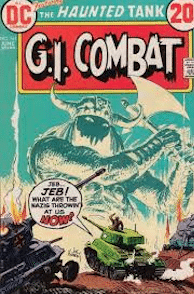WARNING: THE ATTACHED VIDEO CONTAINS IMAGES OF MUSCLEBOUND MEN IN SKINTIGHT OUTFTS, BUXOM DAMSELS IN DISTRESS, NOBLE GIANT ABORIGINALS, FEARSOME MONSTERS – AND THEY’RE ALL CANADIAN
Why is it that so much of humanity loves superheroes? Come on, admit it, you too have idolized one of those men or women in themed, outlandish outfits – generally with those weird boots that fold down at the top of the calves – that populate the pages of most of the millions of pages of comic books that have been published in the last century.
Read Also

Trump’s trade policies take their toll on Canadian producers
U.S. trade policy as dictated by president Donald Trump is hurting Canadian farmers in a multitude of ways.
My favourite wasn’t really a superhero but a man with a supernatural connection to a long-dead Confederate U.S. general. This, of course, was Jeb Stuart and The Haunted Tank. (I’ve been recently re-collecting those comics I first bought new in the early 1970s.)
That mean looking’ dude above is actually Attila, coming to mix it up with the haunted American tank. Sadly there were few Canadian superheroes for me to bond with when I was a child. The first one I was crazy about, according to my mother, was Captain America.
But there was a time when there was a pantheon of Canadian comic book superheroes, and some of those are being resurrected and their original tales of mighty struggles and conflicts being given back to the Canadian consciousness.
I won’t talk too much about that here, because I made the video below for you to go look at, but I’m going to mention an interesting element here that I think has direct relevance to communities in rural Western Canada: Kickstarter and crowd-funding.
These heritage comic book projects have only been possible because of Kickstarter, an online way to raise money from many different little people (like you and me). There are other online fundraising networks and companies too. (One artist I follow on Bandcamp is raising money for his next album on a music-oriented fundraising site, according to an email I got a couple of days ago.)
The way these work is that artists, creators, restorers, or whatever put up an explanation of a project they want to undertake, usually offer various sorts of rewards for various levels of contribution, and then hope to collect enough money for the project to go forward. (If the project doesn’t go forward, no money is taken from backers.) Most projects on Kickstarter are artistic in nature, but I also found some that were farmy and ruralish,
It seems to me that using crowd-sourced funding to gather money for many rural projects would make sense. Rural and farm communities often have small, dispersed populations and widespread diasporas of people that have moved away but still feel connected. Crowd-funding heritage restorations, hockey rink improvements, even something like setting up a small town dinner theatre could work nicely.
I don’t know what type of crowd-funding site, network or company would work best for small-towny and rural projects, but one could probably work well.
As Hope Nicholson, the heritage comic book reviver you hear in the attached video, noted to me at the very end of our conversation, it’s sometimes easier to get financial support from 2,000 little people like you and me than from traditional financial institutions or commercial interests.
It’s just an idea but I think it could work for some things. It’s already worked on me: after getting excited about Brok Windsor I contributed to that project, then funded another one put up by musician Jason Webley. And what Hope says in the interview is true: it’s fun.















